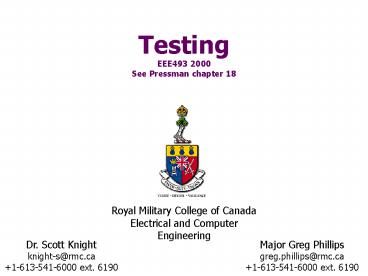Testing EEE493 2000 See Pressman chapter 18 PowerPoint PPT Presentation
1 / 16
Title: Testing EEE493 2000 See Pressman chapter 18
1
Testing EEE493 2000See Pressman chapter 18
Royal Military College of Canada Electrical and
Computer Engineering
- Major Greg Phillips
- greg.phillips_at_rmc.ca
- 1-613-541-6000 ext. 6190
Dr. Scott Knight knight-s_at_rmc.ca 1-613-541-6000
ext. 6190
2
Testing in the software lifecycle
System requirements
Software requirements
Analysis
Design
Coding
Imagine this process laid out on a calendar.
Think as a software manager. What is the problem
with this view of testing?
Testing
Maintenance
3
Testing Strategies
- specify product requirements before testing
commences - state testing objectives explicitly
- understand the users of the software and develop
profiles for each user category - this allows testing to focus on actual use
- emphasize rapid cycle testing
- build software that tests itself (antibugging)
- use formal technical reviews prior to testing
- use formal technical reviews on the test strategy
and the test cases themselves - develop a continuous improvement approach for the
testing process
4
Testing and Inspections
Interaction Faults
Execution Faults
Static faults
Faults
Inspection
Unit Test
Integration Test
- Recall
- inspections are most cost effective way to
remove faults - inspections seldom remove all faults
5
User testing
- early testing of prototype systems
- designed to
- elicit or improve understanding of product
requirements - validate user interface designs
- find optimal user interface designs
- must be planned, structured, managed
- data must be analyzed
- must occur early enough in the process that the
results can be incorporated into the product
6
No user testing on this ballot
- may determine the outcome of the US election
- 19000 discarded ballots because holes 2 and 3
were both punched - statistically, 4000 votes for Buchanan that were
probably intended for Gore
7
Unit testing
- testing on an individual module, class, unit
- based on the module specification
- normally performed by the developer responsible
- tests should include
- data flow across module interface
- local data structures and access to global data
structures - selective coverage of execution paths
- error handling code
- boundary tests
- first and last elements, first and last
iterations, etc.
8
Building Unit Tests
- Pressman says
- After source level code has been developed,
reviewed, and verified for correspondence to
component-level design, unit test case design
begins. - Beck says
- Any program feature without an automated test
simply doesnt exist. - Unit tests frequently require
- stubs code that simulates other modules that are
not yet available - drivers code that sets up the test, produces
input data, tests output data for completeness - Stubs and drivers are overhead using them is an
economic decision
9
Smoke Testing
- What is a smoke test?
- A series of tests designed to expose errors that
will keep the build from properly performing its
function - The intent should be to uncover show stopper
errors that have the highest likelihood of
throwing the project behind schedule - The smoke test should exercise the entire system
from end to end (does not have to be exhaustive
but should expose major problems) - The smoke test should be thorough enough that if
the build passes, you can assume it is stable
enough to be tested more thoroughly - By analogy to testing electrical circuits plug
it in and see if it smokes.
10
Integration Testing
- may be performed
- top down
- test the top module using stubs to represent
lower modules - as lower modules become available, stubs are
removed - lower modules may be added depth-first or
breadth-first - bottom up
- test the bottom modules using drivers to
represent higher modules - collect modules from the bottom up into larger
and larger clusters - in some combination (e.g., sandwich
integration) - eventually culminates in a completely assembled
system - should be started as early in the process as
possible (big bang integration is a disaster)
11
Regression Testing
- any time changes are made at any level, all
previous testing must be considered invalid - can do regression testing at unit, integration,
and system level - this means tests must be re-run to ensure the
software still passes - re-running previous tests is regression testing
- to be practical, requires automated test suites
- particularly problematic for user interface
software
12
Stress Testing
- most systems have requirements for performance
under load, e.g., - 100 hits per second
- 500 ambulances dispatched per day
- all data processed using 70 processor capacity
while operating in flight mode with all sensors
live - systems with load requirements must be tested
under load - simulated load scenarios must be designed and
supported - frequently requires significant test code and
equipment to adequately support
13
Acceptance or Validation Testing
- complete when the software performs in a manner
that can reasonably be expected by the customer - who gets to decide whats reasonable?
- validation tests demonstrate conformity with
requirements - failures are recorded on deficiency lists and
must ultimately be addressed - normally must include a configuration review
- where requirements are unclear or the customer
base is broad, may use alpha and beta testing - exposes incomplete software to the customer
- customers may be willing to use and report faults
in exchange for early access to capabilities
14
System Testing
- software is only one element of the system. Also
includes, people, data, procedures, documentation
and hardware - ultimately, the entire system must be tested for
effectiveness - particular concerns include
- recovery testing
- recovering from system failures
- security testing
- verifying that protection mechanisms will protect
against improper penetration
15
Review
- inspect first!
- user testing
- unit testing
- smoke testing
- integration testing
- regression testing
- stress testing
- acceptance or validation testing
- system testing
16
Next ClassProcess Metrics

